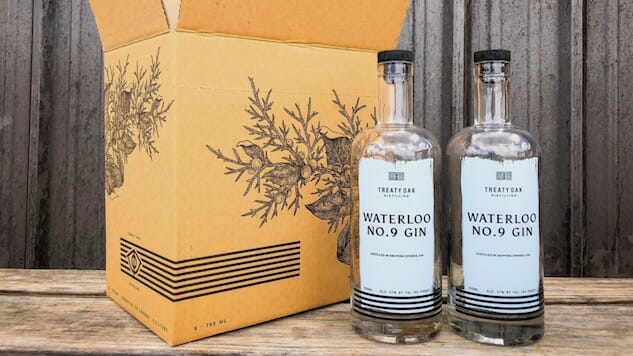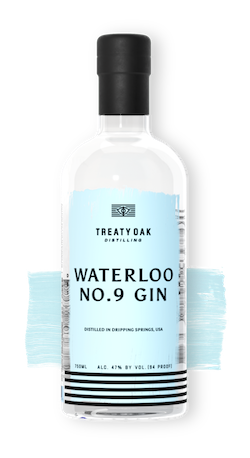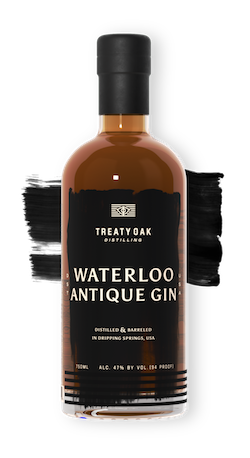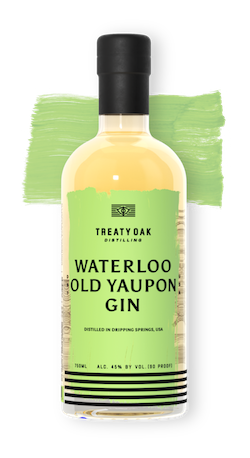Treaty Oak Distilling is Betting Big on Gin
Photos via Treaty Oak Distilling/Facebook Drink Features Treaty Oak Distilling
In 1815, Napoleon’s conquest came to a bitter end at the Battle of Waterloo, when the British defeated the French Emperor and ended his Hundred Days of rule since returning from exile to Europe. And while it’s tempting to use Napoleon’s ravenous appetite for expansion as a metaphor for the desires for exponential expansion lurking in the business models of most U.S. craft distillers, in the case of Treaty Oak Distilling in 2006 as the fourth distiller in Texas and the first to produce rum and gin in the Lone Star State—it’s almost the inverse. When they announced this July that their small line of Waterloo No. 9 gins would be distributed in a handful of states that include California, Tennessee, and Virginia, they also slowed down their on-site beer program and cut two spirits from their line-up: Starlight Vodka and their famed Treaty Oak Rum. They did this partly in response to the ever-growing competitive boutique rum market, but also to reflect how their own drinking habits have changed.
And if the line of gins is any indication, the renewed focus has paid off. The Austin-based distillery sources the unfiltered water from nearby limestone-fed springs, and uses a host of Texas-grown ingredients for its base botanicals, including lavender, pecans, coriander, and grapefruit zest.

The flagship, the Waterloo No. 9 gin, bottles at 94 proof to maximize the vapor infusion used in the distilling process, and it really lets the ingredients shine—a clean, bracing mixture of juniper, coriander, anise, ginger, and citrus. It perfectly embodies the New Western Gin style, which started in the early 2000s as a way to play down the typically dominate taste of juniper to highlight a richer, more complex flavor profile.

Their Waterloo Antique Gin, meanwhile, looks to the centuries of tradition of Dutch jenevers distillers. Treaty Oak ages their gin for 18 to 24 months under the hot Texas sun in first-use medium-char American white oak barrels to denote flavor profiles more akin to whisky—another spirit that the distiller makes. As you’d expect from barrel-aging, the flavors and aromas run deep, evoking hints of nutmeg and leather that nicely compliment the herbal notes of the base Waterloo No. 9.

But perhaps the Waterloo Old Yaupon—the latest release in their gin line—best embodies the distillery’s locals-only focus. Their take on a traditional Old Tom, this spirit integrates honey produced from wild yaupon. A member of the holly family, the plant is prevalent in Texas and other stretches of the south, and was once used widely as a tea thanks to its ample quantities of caffeine. But this is no attempt at making a caffeinated gin. The spirit doesn’t foster any noticeable energy boosts. Instead, the yaupon joins forces with other botanicals—juniper, kaffir limes, anise, orris root, and wildflower honey—to create a spirit that drinks both herbal and earthy. But it’s also brightly citric, just a touch sweet, and unlike almost any other gin on the market.
Their affection for the Texas heartland and unexpected flavors also inspired the upcoming Local Gin Project, a collaborative series where the distillers will craft regional gins across various parts of the country, utilizing ingredients common in their area. And, as Austin 360 reports, other gins—a Texas gin and a West Coast gin, as well as a collaboration with a Georgian chef to make a “deep south” gin—are in the works.
Those new expressions probably won’t make the shelves of the states that are now stocking Treaty Oak. But the gin quality might inspire you to show up to the distillery in person and check out what’s on offer when you next visit Texas. Until then, look for the three new releases as Treaty Oak starts to branch out from their Texas roots.
